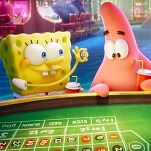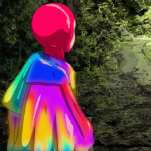In Gameological Unplugged, Samantha Nelson looks at trends and new developments in the vast world of tabletop games.
When I was in middle school and high school, I was obsessed with Magic: The Gathering. I spent most of the money I got from my allowance and after school job on booster packs, keeping up with the new sets and building decks to play against my friends whenever I had an opportunity, which included before school, at lunch, during class, and on weekends. When I went to college, I met people who were far more serious about the hobby than my friends from home. They’d spent more money on cards and done more research to build their decks. Given the choice between stepping up my investment and abandoning the hobby altogether, I did the latter, finding other games to spend my time and money on.
I’ve heard variations on this story countless times: tales of disillusioned collectible card game players who put away their decks years ago when the hobby became too onerous. Now game designers are trying to lure us back with free-to-play digital CCGs, three of which are currently in open beta.
The biggest name in the business right now is Blizzard Entertainment, which put Hearthstone: Heroes Of Warcraft into open beta in February. Players assume one of nine characters from the Warcraft computer games, each representing a different class found in World Of Warcraft. The game’s production value is high, with voice acting for the characters and sound effects for the minions and spells they hurl against each other. While you’re considering your move, the mage Jaina Proudmore might muse “What to do, what to do?” and if you wait too long, a fuse will cross your battlefield, warning to take your turn soon.
While the graphics are impressive, the rules are basic. Most cards just have a single ability, like Charge, which allows fighters to attack as soon as they’re played, or Taunt, which diverts the attention of enemy minions. The game is easy to pick up, but it lacks a lot of the nuance of other CCGs. The most interesting component is that Hearthstone lets the player take actions that don’t involve playing cards—you can often attack an opponents or their minions directly.
Lightmare Studios’ Infinity Wars, which launched its open beta on Steam in February, offers more complexity and shows how digital CCGs can use the medium to offer designs that would be much harder to incorporate into a cardboard-based game. Each of the cards are animated, making them seem like Magic cards that wizards in Harry Potter might play with. But the game’s biggest distinction is that all players choose what they’re going to do and then resolve their turns at the same time.
Players move their cards between support, assault, and defense zones to protect their base and to set up attacks on the enemy, and you must try to predict how your opponent will act—you won’t get to react until the smoke has cleared. There are seven factions, each with their own play styles, that you can mix and match depending on what commanders you’re fielding. Luckily, Lightmare does a good job of teaching players how to use different strategies to their advantage with a campaign mode that compels you to try a variety of different decks. The plot is thin as can be, but paired with the cards you get as a reward for completing missions, it’s enough to justify what would otherwise be an extensive tutorial.
Stone Blade Entertainment’s SolForge, the product of a collaboration between Magic creator Richard Garfield and a team of professional Magic players, is the game most likely to appeal to serious CCG fans. Like Infinity Wars, its primary design feature would be hard to pull off with physical cards. Every card in SolForge has three levels. Once you play the lowest level card, you have a chance to get the upgraded version in a future hand.
Often, the escalating levels of a card follow a simple progression, offering increasing bonuses or doing incrementally higher damage. But sometimes the change is more creative and weird, like a plant creature that’s tiny and easy to kill at level one, a dormant tree that can’t attack at level two, and an enormous, dangerous monster at level three.
These digital CCGs have appeal beyond their novel rules. Players get starter decks for free and unlock additional cards as they play. It produces the same thrill I used to get from tearing into a freshly purchased booster with the added bonus that I didn’t have to fork over any cash to get it. Hearthstone even allows you to “disenchant” cards when you have too many duplicates and craft the disenchanted fodder into new cards you might want. SolForge’s developers have said they plan to add a similar system.
While I enjoyed the time I spent meticulously sorting and laying out my Magic collection so I could build a new deck, I’ll admit that doing the whole thing digitally is far more convenient. I can easily see what cards I have for a given faction or character and break them down by cost so I know that I have good options for every stage of the game. Plus there’s never a risk that I’ll bend a corner or spill a drink and ruin my cards in the process.
Yes, you can still pour plenty of money into these games, and there are players doing just that by buying packs and shelling out for admission to digital tournaments run by Hearthstone and SolForge. But you can also acquire packs and pay your entrance fee using in-game currency, which you earn by playing.
The games also have formats that are friendly to those who don’t want to worry about having every card they need to build the perfect deck. Hearthstone and SolForge have modes that let players compete using decks they make up on the fly with a limited card pool. Infinity Wars offers a weird format where players’ decks are melded together, so your opponents rare cards could wind up in your hand. The result is that the time you’re willing to spend practicing and getting to know the cards is more valuable than an extensive collection.
Each of these games has promised that future updates will bring new features to keep players hooked. Considering that they’re CCGs, you can also expect a constant stream of new cards. The question is whether the glories of online play are enough to stave off the usual CCG fatigue. Will the digital conveniences be enough to keep me and others like me invested and coming back for the thrill of opening a pack and devising new decks? Or will we lose interest the same way we did in their cardboard counterparts—except without the shoebox of cards to remind us of our lapsed hobby?







































